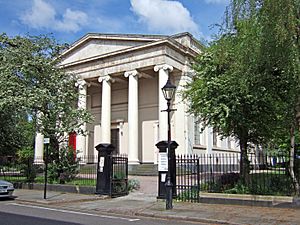St Bride's Church, Liverpool facts for kids
Quick facts for kids St Bride's Church, Liverpool |
|
|---|---|

St Bride's Church, Percy Street, Liverpool
|
|
| 53°23′49″N 2°58′08″W / 53.397°N 2.969°W | |
| Location | Percy Street, Canning, Liverpool |
| Country | England |
| Denomination | Church of England |
| Churchmanship | Progressive / Inclusive Church |
| History | |
| Status | Active |
| Dedication | St Bride |
| Consecrated | 29 December 1830 |
| Architecture | |
| Functional status | Parish church |
| Heritage designation | Grade II* listed building |
| Designated | 28 June 1952 |
| Architect(s) | Samuel Rowland |
| Style | Neoclassical |
| Years built | 1829–1831 |
| Administration | |
| Parish | St. Luke in the City Team |
| Deanery | Deanery of Toxteth & Wavertree |
| Archdeaconry | Archdeaconry of Liverpool |
| Diocese | Diocese of Liverpool |
St Bride's Church is a historic Church of England parish church located in the Canning area of Liverpool, England. It is famous for its beautiful architecture and its important role in the local community.
Contents
History and Design
A Church Inspired by Ancient Temples
St Bride's Church was designed by an architect named Samuel Rowland. Construction began on August 29, 1829, and the church was officially opened on December 29, 1830. It was built for a minister named Reverend James Haldane Stewart.
Because of its historical and architectural importance, St Bride's is a Grade II* listed building. This means it is a very important building that is protected by law to preserve it for the future.
What Makes Its Architecture Special?
Many people think St Bride's is the best example of Neoclassical style in Liverpool. This style was inspired by the grand buildings of ancient Greece and Rome.
The church looks like a classical temple. At the front, it has a huge porch, called a portico, with six large Ionic columns. Ionic columns are a type of column known for the scroll-like shapes at the top.
Inside, the church has a beautiful stained-glass window at the east end. It was made around 1905 in a style from the Renaissance, a famous period of art in Europe. There are also monuments inside, including one for Reverend Stewart, who died in 1854. Another monument remembers Mr. WM Foster, his wife, and their servant, who sadly drowned when the steamship Rothsay Castle sank in 1831.
St Bride's Today
St Bride's is much more than just a historic building. It is still an active church that holds regular services.
It has also become a popular venue for community events. The church has hosted art shows for the Liverpool Biennial, a major international art festival. It also serves as a welcoming space for charities like Refugee Women Connect, Micah, and the British Red Cross, which help people in need.
On top of that, St Bride's is a place for music. It is often used for concerts and even has its own professional recording studio inside!
See also
- Architecture of Liverpool
External links
- St Bride's Liverpool – official website


